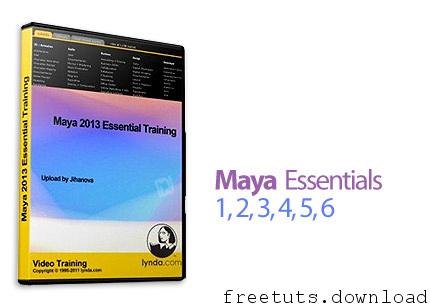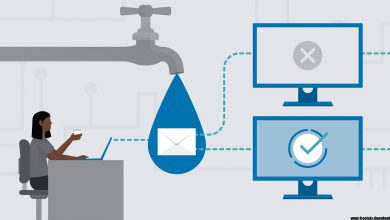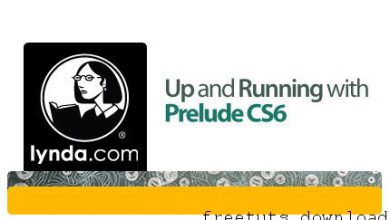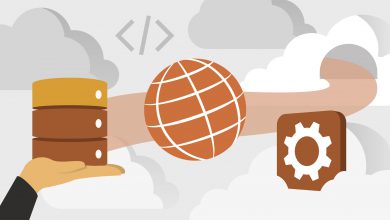Maya Essentials 1,2,3,4,5,6

Maya Essentials 1,2,3,4,5,6 – Maya Tutorial, 3D Modeling Software and animation production
Topics of “Maya Essentials 1: Interface and Organization” include:
– Configuring your computer to work best with Maya
– Setting preferences
– Enabling plug-ins
– Using the Hotbox
– Using the Move tool
– Manipulating pivots
– Understanding the Channel Box
– Creating hierarchies
– Hiding and showing objects
– Working with selection masks
This installment of Maya Essentials covers the basics of the polygonal modeling toolkit. Author George Maestri delves into the theory behind popular polygonal modeling techniques, then walks through the basic process of creating objects, modifying them with Soft Select, and working with subdivision surfaces. The course also includes more advanced techniques such as cutting faces and splitting polygons with the Edge and Bevel tools, creating holes and protrusions with Booleans, and deforming an entire object with lattices. An additional chapter is dedicated to edge loops, which can be used to create and organize detail in models.
Topics of “Maya Essentials 2: Polygonal Modeling Techniques” include:
– Creating and modifying polygonal objects
– Editing with reflection
– Smoothing objects
– Keeping faces together
– Using the Polygon Bridge tool
– Selecting and editing edge loops
– Spinning edges
– Working with objects history
– Modeling symmetrically
– Merging vertices
– Combining objects
– Using the Crease tool
NURBS, or non-uniform rational basis splines, are part of a 3D graphics modeling strategy used to generate curves and surfaces that are smoother than is possible with polygons. NURBS Modeling Techniques provides a thorough introduction to this modeling toolkit. The course explains the basic theory behind NURBS, starting with NURBS primitives and sculpting surfaces, and then through the modeling tools (Trim, Stitch, Project, and more) used to refine NURBS models in Maya. Author George Maestri also cover techniques from using insert isoparms to add detail, to creating arcs and text, to converting NURBS to polygons.
Topics of “Maya Essentials 3: NURBS Modeling Techniques” include:
– Creating NURBS primitives
– Manipulating NURBS surfaces and curves
– Detaching NURBS surfaces
– Creating Bezier curves, arcs, and text
– Opening and closing NURBS curves
– Duplicating curves
– Working with the Resolve, Loft, Extrude, and Planar commands
– Creating curves on a surface
– Trimming surfaces
– Working with NURBS Booleans
Materials define how the surface of 3D objects appear and lend them color, transparency, and texture that allow you to view the characteristics of a surface. This course introduces the basics of creating materials in Maya. Author George Maestri presents the basic material types as well as how to apply and align bitmap textures. He also discusses the concepts behind transparency, specularity, and reflectivity, which impact the appearance and light receptiveness of materials.
Topics of “Maya Essentials 4: Creating Textures and Materials” include:
– Understanding the basic materials
– Creating and applying maps
– Working with the Hypershade window
– Using bitmaps as textures
– Creating reflections
– Using bump vs. displacement mapping
– Projecting textures on surfaces
– UV mapping a complex object
Animation Tools is a focused course that covers the basics of animating in Autodesk Maya, including setting keyframes, working with animation editors, and automating animation with constraints and simple rigs. Author George Maestri also shows how to create motion trails and ghost objects and construct animation cycles, an alternative way to loop your animation with the Graph Editor and Curves.
Topics of “Maya Essentials 5: Animation Tools” include:
– Understanding the animation interface
– Animating objects and their attributes
– Creating, copying, and adjusting keyframes
– Creating breakdown keys
– Animating objects along paths
– Hiding, locking, and limiting channels
– Fitting skeletons to a mesh
– Deforming a mesh with the Skin tool
– Animating a skeleton
This installment of Maya Essentials covers the basics of rendering and lighting tools in Autodesk Maya. Author George Maestri goes over the standard renderers and lighting types, and then goes into features such as render layers and advanced lighting. In particular, the course shows how to manipulate lights, add depth of field, and create bokeh effects and reflections—giving your scene just the atmosphere and drama you want.
Topics of “Maya Essentials 6: Lights and Rendering” include:
– Adjusting the Render Settings menu
– Adding depth map and raytrace shadows
– Understanding the principle of light decay
– Creating cameras
– Using Motion Blur in Maya and mental ray
– Using Final Gather for natural illumination
– Rendering transparent materials with caustics
– Batching rendering
Screenshot Tutorials/Courses
Info Tutorials/Courses
Language of instruction: English
Lecturer: George Maestri
Level: Introductory
Training time: 1 hour + 35 minutes + 17 minutes +2 hours +1 hour +2 hours + 18 minutes + 51 minutes + 1 hour + 20 minutes + 52 minutes + 1 hour
File size: 218.6 + 324 + 362.17 + 245.67 + 228.95 + 235.19 MB
https://drive.google.com/open?id=1Zg4XgiFAIpn_OgVI179KuzRfHufamgoO
https://drive.google.com/open?id=1XgLWtUgjDNh5eLXy1bgwwUuW6mwYxCks
https://freeshadow-my.sharepoint.com/:u:/g/personal/hoquangdai_abcda_tech/EXAh7u0B6E1InkagEEoTno8Bbbb12bmz_hju8wHdP8T5TQ?e=GCiSeV
https://drive.google.com/open?id=1c86fVZl7tmL1BE4V4-3yRuI4we7xn3fR
https://drive.google.com/open?id=1COQHejW18y4eRC0QYdN_Mr2Pv5rTiKSb
https://freeshadow-my.sharepoint.com/:u:/g/personal/hoquangdai_abcda_tech/EZ3wp6Rb4QVHrzk2E0PW3ToBHQja40GEYrXGmDME4kGUvA?e=NgeSMy
https://drive.google.com/open?id=1xfrH_HujIOla5FodQsBgTH_gIyMilsx8
https://drive.google.com/open?id=1jCfDZGNCT7iI1MxkvzKFJs5nBS1iSLcr
https://freeshadow-my.sharepoint.com/:u:/g/personal/hoquangdai_abcda_tech/EVOAhFgwdT5AqCOH8s7yQ-sButq6UbmUwBFq1NNDEVZoRw?e=Ti6t2S
https://drive.google.com/open?id=15Bl0Ieon4nPw5aGpMlPpCvaWSVLN-NIK
https://drive.google.com/open?id=1UQhCVmkcsHdqGUTGkjFdqcp0NjaUGHNj
https://freeshadow-my.sharepoint.com/:u:/g/personal/hoquangdai_abcda_tech/Ef9mT4aYoutFs2PmvBStgdsB-mPvlaDVcjQEuLk0HxPyow?e=PBZuQP
https://drive.google.com/open?id=1Zfg8jY5OX3lhtLhvQFCmOniPuOMC14W6
https://drive.google.com/open?id=1AB-YBn3lwO7EmQMJJSxJ0JDptpmZcAlf
https://freeshadow-my.sharepoint.com/:u:/g/personal/hoquangdai_abcda_tech/EVCWNa7Z00lLst9NmbqsUukBECSCG1X3n_CYvbnrxTModw?e=xTr7Sy
https://drive.google.com/open?id=17lYBYkXnE378ewPQ7Rp_f3cBx2qj77XW
https://drive.google.com/open?id=1VpNJ3JYRsE9uCy7fO6GNWgLsTHMpZZcw
https://freeshadow-my.sharepoint.com/:u:/g/personal/hoquangdai_abcda_tech/EXEnRm5bRvtEvfHAz4wLX3gBU_1gCiCRsySCnNNEtUqVjA?e=SjWe2A




